One day I had a call from a concerned client. She was stroking her cat’s neck and felt a lump. To soothe her anxiety, I explained that there are various causes of lumps and bumps on cats’ necks and many are easy to treat. I suggested she bring her kitty in for an examination to identify the cause. In this article, we’ll look at the leading causes of lumps on cats’ necks and signs to help you identify different types of lumps. We’ll also explain when you can try to help your cat at home and when it’s time to call your vet. So you know what to expect at the clinic, we’ll share what your doctor may do to diagnose the lumps and provide a cost estimate.
Common causes of lumps on cats’ necks
Some lumps that can appear on your cat’s neck are benign, but others need veterinary intervention. Let’s look at the top causes of lumps on the neck.
1. Benign lumps
When bacteria gets under the skin, it can cause a localized infection. Often the body will wall off the area creating an abscess. Abscesses can commonly appear on the head or top of the neck after cats get in a fight. Below is a picture of a large abscess on a cat’s neck:

The lump is probably an abscess if you notice the following signs:
- Feels soft and malleable
- Swelling under the skin
- Painful when touched
- Reddish color
- Loss of appetite
- Pussy discharge if the abscess ruptures
Feline bodies are adept at isolating infections and forming abscesses, so these types of lumps are common. When your cat develops an abscess, you should contact your veterinarian. These infections will not heal on their own, and if they rupture internally, the bacteria can spread. Depending on the size of the lump and the severity of the swelling, treatment may include:
- Warm compresses
- Lancing and draining the abscess
- Antibiotics
- Antiinflammatory medications
2. Fungal infection
Usually, fungal infections in cats affect the lungs or nervous system, but sometimes the microbes cause a skin infection. Below is a picture showing fungal dermatitis on cat’s face and neck:
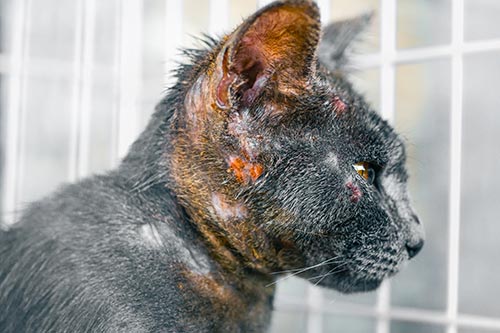
Ringworm is the most common cause of fungal skin infections, but the condition can also arise from Cryptococcosis, Malesezzia yeast, and others. Signs of a fungal skin infection include:
- Hair loss
- Scaling/crusting
- Redness
- pustules(pus-filled bumps)
- Nodules under the skin
- Abscesses with or without draining tracts
Many of the fungi that cause skin infections can also invade the body and affect the lungs or other parts of the body, so you should contact your veterinarian if you suspect a fungal infection. Treatment may include:
- Oral antifungal medications such as itraconazole
- Topical antifungal ointments
- Antifungal shampoos
- Surgical removal of draining tracts, nodules, and abscesses in some cases
3. Insect or skin parasite bite
Pictured below is a cat with an open abscess (on the neck) caused by an allergic reaction to a tick:
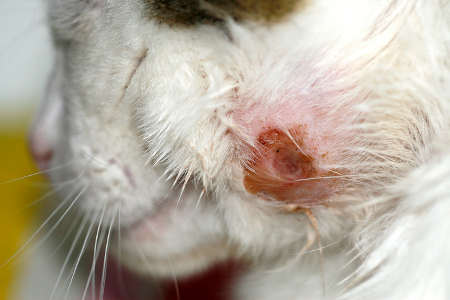
If your cat has a localized reaction to bites from fleas, mites, mosquitoes, or others, he may have a skin reaction. Signs of insect or parasite bite reactions include:
- Raised, red lumps
- Itching
- Presence of fleas, mites, or ticks
- Excessive grooming
If ticks get on your cat, you may also mistake an embedded tick for a lump on the neck.

While the bite reactions usually resolve on their own, you should take measures to prevent them. Most of these pests can carry other diseases that are harmful to cats.
4. Allergic reaction/anaphylaxis
Some cats have strong allergic reactions to environmental irritants or bug bites. Below is a picture showing an allergic reaction with skin rash and hives on a sphinx cat:
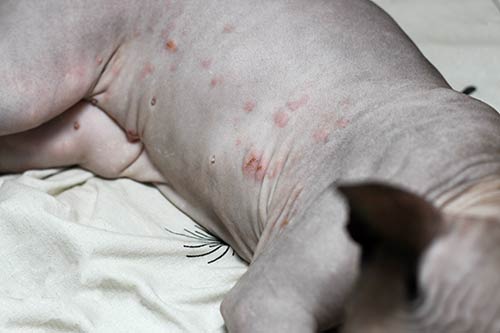
In severe cases, they can go into anaphylaxis, which is a medical emergency. If your cat has an allergic reaction, you may notice:
- Itchiness
- Raised, flat bumps(hives)
- Reddened skin
- Skin sores
- Scabbing and hair loss
- Excessive grooming
- Wheezing/difficulty breathing(anaphylaxis)
- Facial swelling(anaphylaxis)
- Vomiting and/or diarrhea(anaphylaxis)
- Pale gums(anaphylaxis)
- Rapid heart rate(anaphylaxis)
- collapse(anaphylaxis)
When cats have strong allergic reactions such as hives, you should take them to your veterinarian. The doctor can prescribe a cat-safe antihistamine to curb the reaction and test your kitty to try to determine the causative allergens. Allergic reactions are often more severe with repeated exposure, so you want to be prepared and try to prevent future episodes if possible. The pictures below show facial swelling on a cat’s face and neck:


At the first sign of anaphylactic shock, take your kitty to the emergency clinic. This is a life-threatening condition
5. Cyst
Cysts in cats are small lumps that contain fluid or another material. They’re usually benign and non-painful, but they can get infected. Depending on the contents of the lump, it may be round or oval in shape and feel soft or firm.
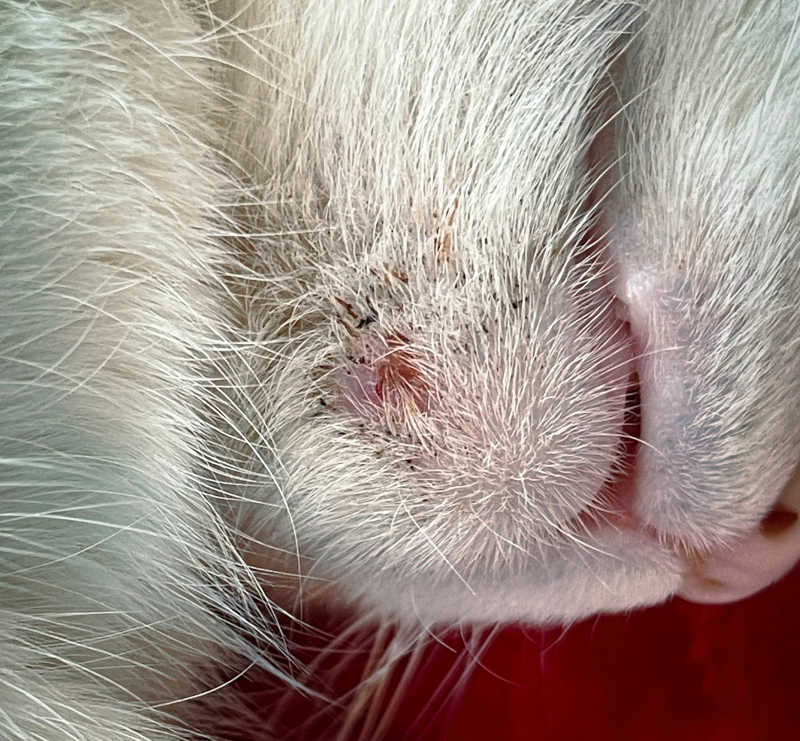
To learn more about various cat cysts, read “7 Types of Cat Cysts.” As long as the cyst doesn’t bother your cat or become infected, you can usually leave it alone. If it becomes problematic, the best course of treatment is surgical removal.
6. Lipoma
Lipomas are benign fatty tumors that can appear on your cat’s neck and other parts of the body. They can feel spongy, soft, or firm, and are fairly free-moving under the skin. Because the lumps tend to grow rapidly in cats and may affect other tissues, they’re usually surgically removed. View more pictures of lipomas.
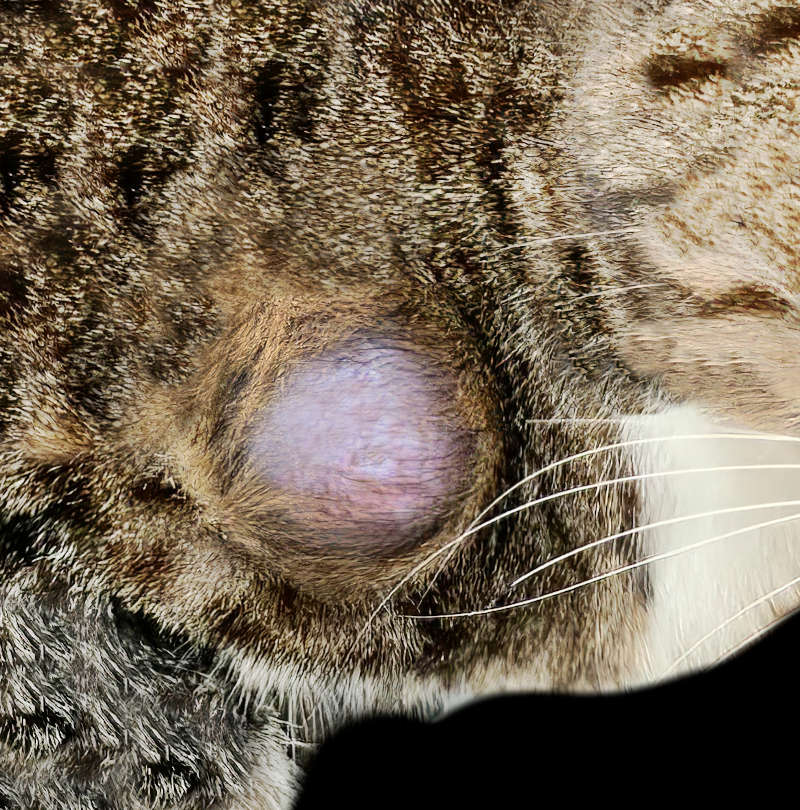
7. Injection site reaction
Some cats react to vaccinations, particularly if the shot is given above the shoulder blades. When this happens, a small skin nodule forms. It should resolve on its own in 3-4 weeks. If the inflammation persists, talk to your veterinarian. In some cases, chronic inflammation can be a precursor to fibrosarcoma(see below).
8. Malignant Lumps
Basal cell tumors: Most commonly found in older cats, basal cell tumors are one of the most common feline skin tumors. They usually appear as single lumps on the head or neck. These lumps range in size from a few centimeters to a few inches. They are firm, hairless, and can be pigmented. View this picture from VeterianKey. Basal cell tumors don’t tend to metastasize to other organs, but they can grow, ulcerate, and become infected. The treatment of choice is surgical removal. Cats have a good prognosis with treatment.
Mast cell tumors: Mast cells are part of the family of white blood cells that are involved in allergic responses. When the cells grow abnormally, they can form masses or nodules in the skin and other organs. While mast cell tumors can occur anywhere on your cat’s body, they usually grow around the neck and head. Signs of a mast cell skin tumor include:
- plaques(firm, flattened areas) or firm nodules
- Itching
- Loss of hair
- Can be ulcerated
View this picture of a mast cell tumor on VeterianKey. These tumors can spread to other body systems including the spleen and intestines, but it’s unlikely. The treatment for mast cell tumors of the skin is complete surgical removal. Most cats recover with a good prognosis for a normal life.
Fibrosarcoma: Fibrosarcomas can appear anywhere on the body. In cats, they may be triggered by an injection site reaction. When they form, these tumors grow rapidly from small, firm lumps to invade local tissues. See this picture on Pug Dog’s Club of America. The masses are slow to metastasize. Signs of a fibrosarcoma tumor include:
- Irregular shape
- A fleshy or firm lump
- Feels fixed to tissues under the skin
- Usually not painful
- Possible ulceration or infection
Treatment for fibrosarcoma is surgical removal followed by chemotherapy or targeted radiation. The prognosis depends on the tumor’s aggressiveness and growth rate, but it’s usually guarded. Fibrosarcomas often recur.
How to identify different types of lumps
Lumps can’t be diagnosed based on visual inspection alone because many growths resemble one another. However, your veterinarian may be able to narrow the list of possible types of lumps your cat has based on certain characteristics.
- Size and shape
- On or under the skin
- Growth rate
- Flat to the skin’s surface or raised
- Level of itchiness or painfulness
- Pigmentation
- Consistency (soft, spongy, firm)
Once he evaluates the tumor’s characteristics, the doctor will need to run some diagnostic tests to confirm the diagnosis. Common tests include impression smears, fine needle aspiration, or biopsies. The type of tumor and its location will dictate which test your vet uses.
Should I visit the veterinarian or wait and see?
In most cases, you should expect to schedule an appointment rather than wait and see because early diagnosis and treatment often help improve the prognosis. You should visit the vet if:
- The lump continues to grow
- The lump doesn’t go away in a few days
- The lump changes color
- Your cat is scratching or rubbing at the area
- Your cat shows signs of pain like crying
- Your cat won’t eat
- Your cat is depressed or lethargic
Signs that you can wait and see
Signs that you may be able to wait and see are largely based on the history and circumstances surrounding the lump.
- You saw a mosquito or other insect bite your cat before the lump appeared
- Your cat recently had vaccinations, and the lump is around the shoulders
- The lump is squishy and moves freely under the skin
- Your cat is acting normally
- Your cat is not itchy or painful
Most lumps should disappear in a week or less. If not, contact your veterinarian.
Diagnosis and estimated cost for evaluating lumps on cats’ necks
When you take your cat to the veterinarian to identify lumps on his neck, the doctor will get a history and examine your kitty. Usually, a visual examination alone will not be enough for a diagnosis. The cost of the office visit and physical examination runs about $50-100. It may be higher if your vet takes blood tests. Based on the history and appearance of the lump on your cat’s neck, the doctor will select the best diagnostic test.
Cytology
Cytology can be run by taking an impression smear or fine needle aspirate. This diagnostic test can run $80-200 depending on the type of sample and whether your vet sends it to a lab or examines it in-house.
- Impression smears may be taken by applying a slide or scotch tape to a surface lump and then examining the cells under a microscope. Results using this method are often inconclusive.
- Fine needle aspiration smears are collected by inserting a fine needle into the lump and pulling back on the syringe plunger. The cells are placed on the slide for examination under a microscope for analysis.
Biopsy
Depending on the type of lump, your vet will collect tissue samples using the incision(removing a partial sample) or excision(removing the entire lump) technique. This is a surgical procedure that requires anesthesia. The tissue sample is submitted to a lab for histopathology. The overall cost of a biopsy including preliminary workup can run about $450-700.
What to do: steps for dealing with lumps on your cat’s neck
1. Routinely check your cat for lumps
Lumps on your cat’s neck can easily go unnoticed if you’re not regularly checking for them. As your cat ages, it’s wise to check your cat’s body every month or so for lumps. Try giving a gentle massage and feeling under the fur to the skin.
2. Take note of any abnormalities
If you feel or observe anything new on your cat’s neck, check it closely and note the size, color, and consistency. Take a picture of the lump if possible.
3. Notify your veterinarian
Contact your veterinarian and report your findings. If you take a picture, ask to text or email it to him. The doctor may advise you to monitor the lump or bring your cat in for an examination depending on the signs and any history of injuries or recent vaccinations.
Frequently asked questions
Are lumps on a cat’s neck always a cause for concern?
Some lumps such as lipomas and most cysts are benign and shouldn’t be a cause for concern. However, others can be cancerous or potentially cause severe illness. When you find a lump, the best thing to do is schedule an exam with your veterinarian.
Should I be concerned if the lump changes in size?
If the lump on your cat’s neck starts to increase in size or change color, you should contact your veterinarian. This often means the infection is getting worse or the tumor is cancerous and growing.
Can lumps on cats’ necks be cancerous?
Some lumps that can appear on your cat’s neck are cancerous. Some of the more common tumors are basal cell tumors, mast cell tumors, and fibrosarcomas.

